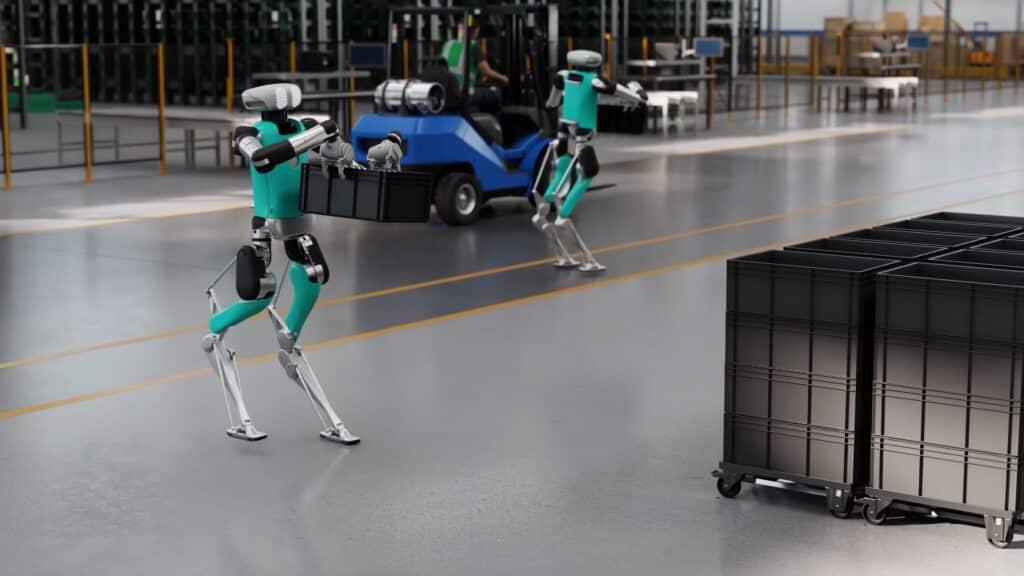New tools and datasets are paving the way for an industrial revolution driven by autonomous robots, visual agents, and real-time simulations.
The global industrial ecosystem is taking a decisive step towards integrating physical artificial intelligence thanks to new initiatives from NVIDIA. At the Hannover Messe trade fair, the company unveiled the Mega Blueprint for NVIDIA Omniverse, a roadmap for testing fleets of robots in highly realistic virtual environments. This proposal comes alongside the launch of a massive open dataset that promises to accelerate the training of AI models for robots, autonomous vehicles, and smart cities.
Digital Twins: The New Training Ground for AI
Physical artificial intelligence—those that act in the real world through humanoid robots, autonomous systems, or smart sensors—requires an intensive validation phase. To this end, NVIDIA proposes the use of digital twins: exact virtual replicas of factories, warehouses, and other industrial facilities capable of accurately simulating complex interactions between humans and machines.
Through its Omniverse platform and the use of the OpenUSD standard, companies can develop these virtual environments and accelerate their innovation cycles without exposing themselves to risks in the real world. Companies like Accenture, Schaeffler, Siemens, Delta Electronics, and Rockwell Automation are already applying this approach to optimize industrial layouts, logistical flows, and collaboration between operators and robots like Digit, developed by Agility Robotics.
Mega Blueprint: A Guide for Mass Robot Deployment
The Mega Blueprint provides a reference workflow that allows for the simulation of interactions between multiple types of robots—such as AMRs (autonomous mobile robots) and humanoids—by combining synthetic data generation and sensor simulation. This approach enables the refinement of navigation, manipulation, and spatial reasoning policies before physical deployment.
Thanks to this closed training cycle, the “brains” of robots learn in virtual environments and, once validated, they can be transferred to the real world, where they continue to learn and feed the system with new data.
Visual AI for Smarter Facilities
In addition to mobile robots, NVIDIA is investing in visual artificial intelligence agents capable of extracting contextual knowledge in real-time from live or recorded videos. These agents can be integrated into visual inspection systems, industrial surveillance, or compliance analysis, increasing safety, efficiency, and space utilization.
Last year, the company already presented its video search and summary blueprint (VSS), which is now being used by industrial partners to enhance their workflows through advanced visual automation.
An Open Dataset to Scale Physical AI
To facilitate the development of this new generation of physical AI, NVIDIA has released a mega dataset on Hugging Face. This initial repository contains 15 terabytes of information, over 320,000 robotic training trajectories, and up to 1,000 OpenUSD SimReady digital assets. An additional block focused on autonomous vehicles, containing video clips in real-world conditions from over 1,000 cities in the U.S. and Europe, will be added soon.
This pre-validated dataset of commercial quality allows researchers and developers to avoid the high costs of collecting real data and speed up the training and testing of AI models for physical applications.
Collaboration with Universities and Research Centers
The use of the NVIDIA Physical AI Dataset has already been adopted by institutions such as UC Berkeley, Carnegie Mellon, and the University of California, San Diego (UCSD). These entities plan to apply the data for training models for autonomous driving, medical robotics, and humanoid home assistants. The dataset’s geographic, environmental, and contextual diversity offers unprecedented value for addressing edge cases and generalization problems.
“This dataset allows us to train AI models that understand the context of the physical world, which is essential for safety in autonomous vehicles or hospital environments,” explains Henrik Christensen, director of the Contextual Robotics Institute at UCSD.
Beyond the Dataset: Tools for Developers
The dataset is complemented by tools like NVIDIA NeMo Curator, capable of processing millions of hours of video in just two weeks using Blackwell GPUs, and new blueprints like the robotic manipulation one (GR00T), which generates synthetic movements based on human demonstrations.
In addition, NVIDIA promotes the learning of these environments through free courses from the Deep Learning Institute, such as Learn OpenUSD and Robotics Fundamentals, aimed at developers of 3D, AI, and automation.
A New Industrial Paradigm
What used to take years of physical testing can now be resolved in weeks through hyper-realistic simulations. Industrial digitization is moving towards a future defined by software, where data, digital twins, and physical AI converge to transform manufacturing, logistics, and automation on a global scale.
With these tools, NVIDIA not only drives innovation but also proposes a new open standard for the safe, efficient, and scalable development of embodied artificial intelligence.
via: Nvidia

